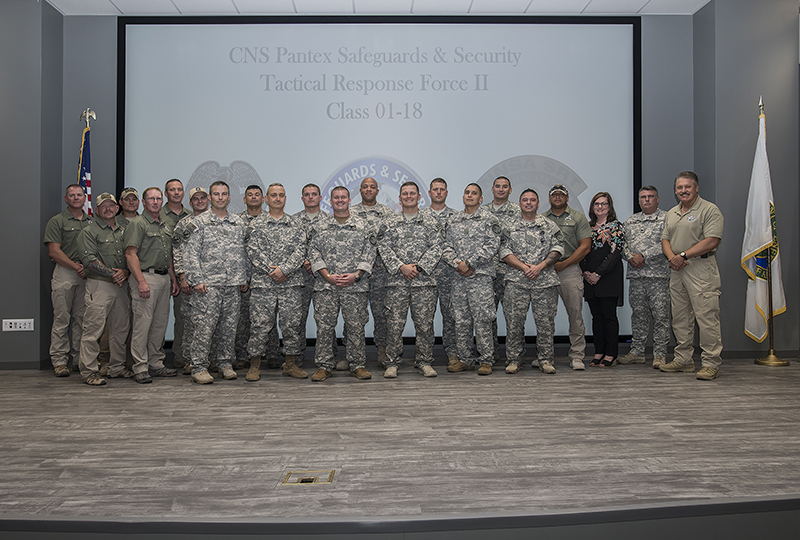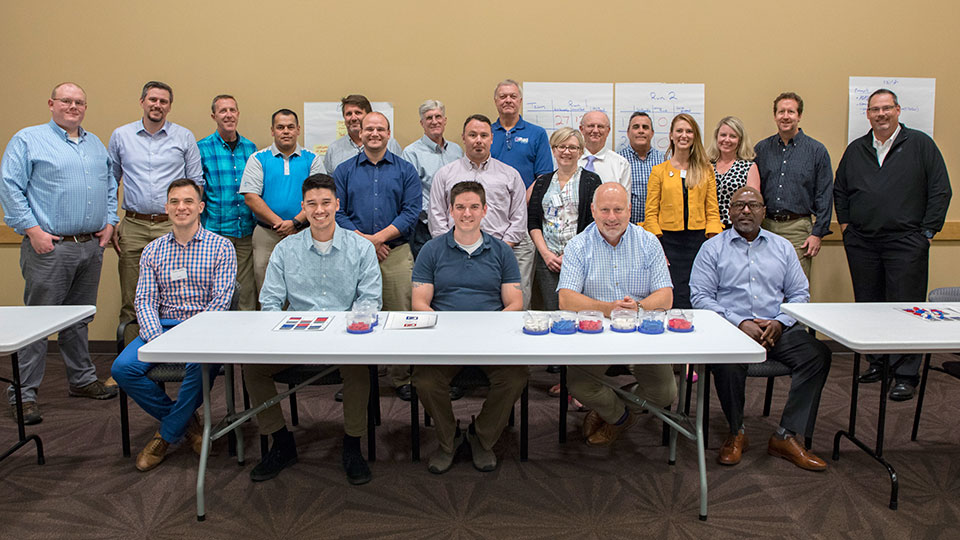Pantex Blog
Pantex Special Response Team welcomes 13 new members
The Pantex Special Response Team recently welcomed 13 new members during the Tactical Response Force II class graduation. The TRF-200 graduates completed five weeks of rigorous tests and evaluations and an extra week of Basic Tactical Entry training.
Kristy McWilliams, Pantex senior director for Safeguards & Security, said, “These graduates represent the best of the best. They were challenged mentally and physically, and I commend them for their dedication and hard work.”
The graduates completed 17 testable objectives and were evaluated each day on safety, task performance, and marksmanship. They applied their battle and marksmanship skills in live fire exercises and force-on-force scenarios under day and night conditions. The group spent more than 100 of their 240 course hours in the on-site shoot house, where they trained in live fire close quarter battle.

Top security professionals recognized by NNSA
The Pantex Security Posture Change Working Group received the NNSA Security Team Award for 2017. The team received the award for their dedication and commitment to the Pantex Protective Force posture realignment, a major undertaking with numerous benefits. When combined with other security assets, the realignment provides an extremely robust security system by leveraging the use of new technologies to more effectively secure the site while increasing the survivability and lethality of the fighting force.
“This team demonstrated innovation,” said Lyle Cary, CNS vice president of Safeguards, Security & Emergency Services. “We put a challenge out to review the posture to see if we can leverage technologies, tactics, techniques, procedures, to become more efficient, and to not only preserve effectiveness, but improve our effectiveness as well. And this team went after that with gusto.”
“This was a huge undertaking by the entire Safeguards & Security staff,” said Kristy McWilliams, senior director of Pantex Safeguards & Security. “While the award recognizes 12 of the leaders of this effort, it truly was a team effort that required integration among all the security disciplines. I am proud of the teamwork, commitment, and dedication of everyone who had a hand in making this effort a success. Their hard work contributes each and every day to ensuring the safety and security of our nation’s valuable resources.”
Invest in our sustainable future: Buy ‘green’
The Department of Energy’s Sustainable Acquisition Program is committed to “green purchasing,” giving preference to products that are energy and water efficient, made from biobased or recycled content, are nontoxic or less toxic than conventional alternatives, release nonozone depleting chemicals, and support the overall use of alternative fuels and fuel efficient products.
A broader focus

Pantex and Y 12 are recognized across the Nuclear Security Enterprise as sustainability champions. Now, Sherith Colverson, who recently joined CNS, will lead broader efforts at both sites to evaluate CNS’s purchases to ensure they meet or exceed federally required sustainability criteria.
“We do a significant amount of recycling our different materials streams to keep them from becoming waste streams,” said Colverson of Sustainability and Stewardship Programs. “Now, we’re going to take the next step. My focus will be on helping organizations purchase green products to begin with.”
Colverson’s role is to provide oversight and assistance to CNS employees, which includes interpreting and implementing all facets of DOE’s Sustainable Acquisition Program. She will help organizations comply with Environmental Protection Agency and U.S. Department of Agriculture requirements as well as Executive Order 13834.
“The Sustainable Acquisition Program simply ensures that our federal government leads by example in protecting the health of our shared environment and reducing environmental impact through the purchase of sustainable products, as well as services,” Colverson said. “It is an activity that spans all organizations. It is part of our contracts, cafeteria service, construction and remodeling of buildings, custodial operations, vehicle fleet, grounds and facility maintenance, operations and office environments, and information technology.”
Biobased products
One of the ways CNS can lead by example is by purchasing biobased products. Biobased products are derived from plants and other renewable agricultural, marine, and forestry materials and provide an alternative to conventional petroleum derived products. Products include lubricants, cleaning agents, inks, fertilizers, and bioplastics. Some of these products, such as hand soaps and hand sanitizers, are already used throughout Pantex and Y 12.
“I look forward to learning more about how both sites are operating, building, and providing maintenance with current products,” Colverson said. “I’m here to work with all organizations to find those sustainable and biobased products or services that could potentially help increase efficiency, optimize performance, reduce environmental impacts, and cut costs.”
CNS hosts Manufacturing Practices Lean Summit
CNS hosted a Manufacturing Practices Lean Summit to grow continuous improvement through a community of sharing and practice. The summit, held at Y 12, included attendees from each site within the Nuclear Security Enterprise as well as the United Kingdom’s Atomic Weapons Establishment.
“A significant part of our operation is continuous improvement, and we learn from others in the complex,” said Pantex Site Manager Todd Ailes. “The summit has given us an opportunity to share lean strategies to help us continue forward. Our work is about people, core missions, and techniques for continuous improvement.”
Reed Mullins, senior director of Production Operations at Y 12, said, “We’re coming together as a complex to break out of our silos, to learn from our mistakes, and to look at what did and did not work well. Our goal is to better support our people daily.”

Pantex to hold external hiring event
Pantex is holding a targeted external hiring event on Saturday, July 28 from 9 a.m. to 2 p.m. at the JCDC. Applicants are encouraged to pre-register by applying for requisition 18-0000 on pantex.energy.gov/careers. Submit a resume and identify specialty for the following groups ONLY:
- Cyber security
- Information technology (system architects, service transition)
- Engineering (electrical, mechanical, industrial, engineering techs)
- Planning and control (planners, schedulers, estimators)
- Manufacturing (production managers)
- Metrology
- Supply chain (buyers, contract specialist)
- Skilled crafts: electrician, electronic, instrument, pipefitter, HVAC/refrigeration, fire service, electrical safety
- Security (system administrators, material control, technical security, IT security)
This event is NOT for production technicians, janitors, security police officers, clerks, yard workers, or material handlers. Children not permitted.

